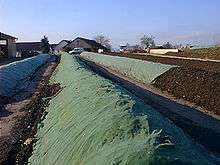Organic fertilizer
Organic fertilizers are fertilizers derived from animal matter, human excreta or vegetable matter. (e.g. compost, manure).[1] Naturally occurring organic fertilizers include animal wastes from meat processing, peat, manure, slurry, and guano.
In contrast, the majority of fertilizers used in commercial farming are extracted from minerals (e.g., phosphate rock) or produced industrially (e.g., ammonia).

Examples and sources
The main organic fertilizers are, peat, animal wastes (often from slaughter houses), plant wastes from agriculture, and treated sewage sludge.[1]
Mineral
The main source of organic fertilizer is peat, an immature precursor to coal. Peat itself offers no nutritional value to the plants, but improves the soil by aeration and absorbing water.

Mined powdered limestone,[2] rock phosphate, and Chilean saltpeter are inorganic (not of biologic origins) compounds, which can be energetically intensive to harvest.[2][3][4]
Animal sources
These materials include the products of the slaughter of animals. Bloodmeal, bone meal, hides, hoofs, and horns are typical precursors.[1] fish meal, and feather meal are other sources.
Chicken litter, which consists of chicken manure mixed with sawdust, is an organic fertilizer that has been shown to better condition soil for harvest than synthesized fertilizer. Researchers at the Agricultural Research Service (ARS) studied the effects of using chicken litter, an organic fertilizer, versus synthetic fertilizers on cotton fields, and found that fields fertilized with chicken litter had a 12% increase in cotton yields over fields fertilized with synthetic fertilizer. In addition to higher yields, researchers valued commercially sold chicken litter at a $17/ton premium (to a total valuation of $78/ton) over the traditional valuations of $61/ton due to value added as a soil conditioner.[5]
Plant
Processed organic fertilizers include compost, humic acid, amino acids, and seaweed extracts. Other examples are natural enzyme-digested proteins. Decomposing crop residue (green manure) from prior years is another source of fertility.
Other ARS studies have found that algae used to capture nitrogen and phosphorus runoff from agricultural fields can not only prevent water contamination of these nutrients, but also can be used as an organic fertilizer. ARS scientists originally developed the "algal turf scrubber" to reduce nutrient runoff and increase quality of water flowing into streams, rivers, and lakes. They found that this nutrient-rich algae, once dried, can be applied to cucumber and corn seedlings and result in growth comparable to that seen using synthetic fertilizers.[6]
Treated sewage sludge
Although night soil (from human excreta) was a traditional organic fertilizer, the main source of this type is nowadays treated sewage sludge, also known as biosolids.

Biosolids as soil amendment is only available to less than 1% of US agricultural land. Industrial pollutants in sewage sludge prevents recycling it as fertilizer. The USDA prohibits use of sewage sludge in organic agricultural operations in the U.S. due to industrial pollution, pharmaceuticals, hormones, heavy metals, and other factors.[7][8][9] The USDA now requires 3rd-party certification of high-nitrogen liquid organic fertilizers sold in the U.S.[10]
Sewage sludge use in organic agricultural operations in the U.S. has been extremely limited and rare due to USDA prohibition of the practice (due to toxic metal accumulation, among other factors).[11][12][13]
Urine
Animal sourced urea and urea-formaldehyde from urine are suitable for organic agriculture; however, synthetically produced urea is not.[14] The common thread that can be seen through these examples is that organic agriculture attempts to define itself through minimal processing (e.g., via chemical energy such as petroleum — see Haber process), as well as being naturally occurring or via natural biological processes such as composting.
Others
- Alfalfa
- Ash[15]
- Blood meal
- Bone meal[16]
- Compost
- Cover crops
- Fish emulsion[17]
- Fish meal
- Manure
- Rock phosphate
- Raw Langbeinite
- Rockdust
- Unprocessed natural potassium sulfate
- Wood chips/sawdust[18]
- PROM
See also
References
- 1 2 3 Heinrich Dittmar, Manfred Drach, Ralf Vosskamp, Martin E. Trenkel, Reinhold Gutser, Günter Steffens "Fertilizers, 2. Types" in Ullmann's Encyclopedia of Industrial Chemistry, 2009, Wiley-VCH, Weinheim. doi:10.1002/14356007.n10_n01
- 1 2
- ↑ "Can I Use This Input on My Organic Farm?". eXtension. Retrieved 25 August 2010.
- ↑ Alternative Farming Systems Information Center. "Organic Production and Organic Food: Information Access Tools". Nal.usda.gov. Retrieved 25 August 2010.
- ↑ "Researchers Study Value of Chicken Litter in Cotton Production". 23 July 2010.
- ↑ "Algae: A Mean, Green Cleaning Machine". USDA Agricultural Research Service. 7 May 2010.
- ↑ "Organic Farming | Agriculture | US EPA". Epa.gov. Retrieved 25 August 2010.
- ↑ "CalOrganic Farms News". Calorganicfarms.com. Retrieved 25 August 2010.
- ↑ "Biosolids: Targeted National Sewage Sludge Survey Report". EPA.gov. January 2009.
- ↑ Schrack, Don (23 February 2009). "USDA Toughens Oversight of Organic Fertilizer: Organic fertilizers must undergo testing". The Packer. Retrieved 19 November 2009.
- ↑ "Organic Farming | Agriculture | US EPA". Epa.gov. Retrieved 2012-01-09.
- ↑ http://www.ewg.org/reports/sludgememo
- ↑ "CalOrganic Farms News". Calorganicfarms.com. Retrieved 2012-01-09.
- ↑ "In a natural organic system, nitrate in the soil is derived from the gradual breakdown of humus". Ecochem.com. Retrieved 2012-01-09.
- ↑ "Managing Potassium for Organic Crop Production" (PDF). CO State Extension.
- ↑ "Phosphorus Fertilizers for Organic Farming Systems". CO State Extension.
- ↑ "Maintaining Soil Fertility in an Organic Fruit and Vegetable Crops System". University of MN Extension.
- ↑ "Organic Materials as *Nitrogen Fertilizers". CO State Extension.
| Wikimedia Commons has media related to Fertilizer. |